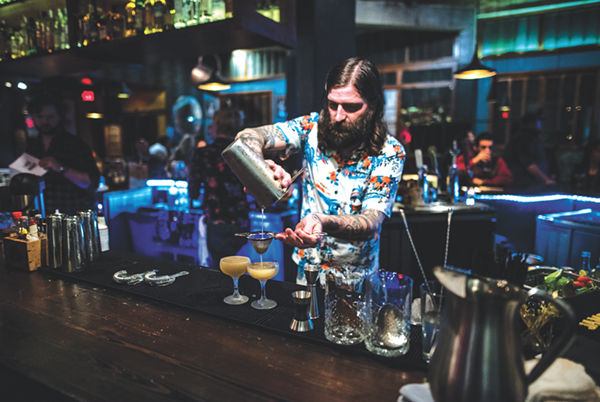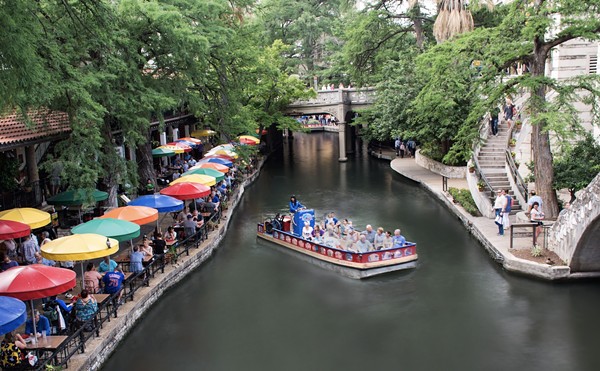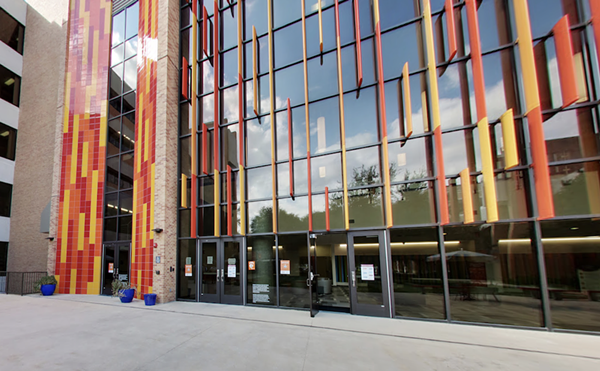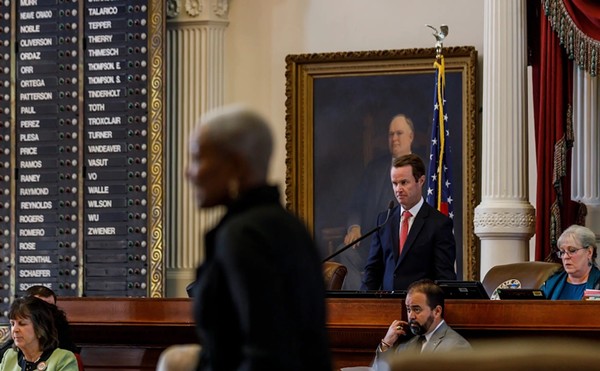San Antonio's Hospitality Industry is One of Its Fastest Growing – and Lowest Paying
By Greg Jefferson on Tue, Mar 27, 2018 at 3:00 pm
Editor's Note: The following is Their Town, a column of opinion and analysis.
This weekend’s NCAA Men’s Final Four will put on display San Antonio’s go-to money-making skills – hosting big events, showing visitors a good time, and leaving national audiences with a favorable impression.
The basketball spectacle starts Saturday and ends with the national championship game Monday night. Downtown hotels, restaurants, bars and nightclubs will be slammed. The walkways along the Riverwalk will be clogged with gawking out-of-towners wearing their college teams’ colors. Jesse Torres, bar manager at Rosella at the Rand on Houston Street, thinks the Final Four will draw crowds big enough to spill over into the parts of downtown that, like his, usually don’t get a bunch of customers here for major events.
“We’re really looking forward to the spike – to seeing people we don’t normally see,” Torres said. Visitors who don’t want to wait an hour or more to eat on the Riverwalk, he said, will likely venture a few blocks out of the major-hotel bubble to see what there is on West Houston Street and other parts of the center city.
It’ll be a big payday. Visit San Antonio, the public-private nonprofit that promotes the city as a leisure and convention destination, expects 93,000 out-of-towners to show up for the Final Four, ready to spend a total of $186 million.
That’ll mean a lot of worn-out servers, bussers, cooks, and bartenders. Hopefully, they’ll go home at the end of it all with their pockets stuffed with tips or payouts.
The Final Four will also be a reminder that the hospitality industry is still one of the biggest and fastest-growing parts of San Antonio’s economy. And it’s definitely one of the lowest paying.
Tourism has been a bedrock industry here at least since HemisFair ’68 put a huge exclamation point on the Riverwalk. State officials used to identify the Alamo as Texas’s top tourist attraction year after year. But that was bullshit. Everyone knew it was the Riverwalk.
It’s the linchpin of an industry – including hotels, amusement parks, restaurants, bars, and entertainment venues – that delivered a $13.6-billion jolt to the city’s economy in 2015, according to a study commissioned by Visit San Antonio and San Antonio Area Tourism Council. Only the military and the health-care and biosciences industry beat its economic impact.
The problem is, and always has been, the low pay.
And there’s another catch – employers in the industry are adding jobs faster than almost anybody else. While the overall number of San Antonio’s nonfarm jobs grew in February by 2.4 percent, year-over-year, leisure and hospitality operators created jobs at a 5.6-percent clip, according to the U.S. Bureau of Labor Statistics.
“Many of the new jobs offered in [San Antonio] have been lower-paying leisure and hospitality sector jobs, not jobs in the higher-paying sectors,” Frost Bank economist Bill Sirakos said.
That’s been true for a long time, but there was a surge in hotel and restaurant hiring in late 2017 because of Hurricane Harvey. The storm drove thousands of Texans from the Gulf Coast to San Antonio and other in-land cities in early September. Families and individuals who could afford it, or at least had enough room on their credit cards, put themselves up in hotels and motels, and ate out.
That jump in hotel, restaurant and other related service jobs is part of the reason San Antonio’s average hourly wage – across all industries – dipped in late 2017 to $23.07. That was $2.49 below the state average and $3.56 below the national, according to a recent report by the Federal Reserve Bank of Dallas.
That may be chilling but it’s not new. San Antonio’s wage-earners have struggled, and failed, to keep up with their counterparts across Texas and the country. Not even the city’s low unemployment rate, which results in employers paying more to attract workers, has closed the gap.
Christopher Slijk, senior research analyst at the Dallas Fed’s San Antonio branch, cites San Antonio’s “relatively high concentration of hospitality, tourism, and lower-wage home health care workers compared to the state, as well as the lower educational attainment compared to the state average.”
Economic-development officials are working to attract better-paying jobs in fields that require higher skills and/or higher education. But there’s no getting around how important tourism is to San Antonio’s economy. You can see it in how they talk about the visitor industry – gingerly.
The following statement from Jennifer Saucedo-Herrera, president of the San Antonio Economic Development Foundation, is a good example.
“With our community’s extensive military legacy and assets, we have the opportunity to lead industries like IT, cybersecurity and bioscience,” Saucedo-Herrera said. “When we grow these target industries, our hospitality, tourism and other service industries are positively impacted as well. San Antonio is characteristically welcoming and collaborative, a unique selling point for this community, and evidenced by the success of our hospitality industry.”
With that, enjoy the Final Four, and dig deep when it’s time to tip your servers and bartenders. If you’re a server or bartender, good luck.
Stay on top of San Antonio news and views. Sign up for our Weekly Headlines Newsletter.
This weekend’s NCAA Men’s Final Four will put on display San Antonio’s go-to money-making skills – hosting big events, showing visitors a good time, and leaving national audiences with a favorable impression.
The basketball spectacle starts Saturday and ends with the national championship game Monday night. Downtown hotels, restaurants, bars and nightclubs will be slammed. The walkways along the Riverwalk will be clogged with gawking out-of-towners wearing their college teams’ colors. Jesse Torres, bar manager at Rosella at the Rand on Houston Street, thinks the Final Four will draw crowds big enough to spill over into the parts of downtown that, like his, usually don’t get a bunch of customers here for major events.
“We’re really looking forward to the spike – to seeing people we don’t normally see,” Torres said. Visitors who don’t want to wait an hour or more to eat on the Riverwalk, he said, will likely venture a few blocks out of the major-hotel bubble to see what there is on West Houston Street and other parts of the center city.
It’ll be a big payday. Visit San Antonio, the public-private nonprofit that promotes the city as a leisure and convention destination, expects 93,000 out-of-towners to show up for the Final Four, ready to spend a total of $186 million.
That’ll mean a lot of worn-out servers, bussers, cooks, and bartenders. Hopefully, they’ll go home at the end of it all with their pockets stuffed with tips or payouts.
The Final Four will also be a reminder that the hospitality industry is still one of the biggest and fastest-growing parts of San Antonio’s economy. And it’s definitely one of the lowest paying.
Tourism has been a bedrock industry here at least since HemisFair ’68 put a huge exclamation point on the Riverwalk. State officials used to identify the Alamo as Texas’s top tourist attraction year after year. But that was bullshit. Everyone knew it was the Riverwalk.
It’s the linchpin of an industry – including hotels, amusement parks, restaurants, bars, and entertainment venues – that delivered a $13.6-billion jolt to the city’s economy in 2015, according to a study commissioned by Visit San Antonio and San Antonio Area Tourism Council. Only the military and the health-care and biosciences industry beat its economic impact.
The problem is, and always has been, the low pay.
And there’s another catch – employers in the industry are adding jobs faster than almost anybody else. While the overall number of San Antonio’s nonfarm jobs grew in February by 2.4 percent, year-over-year, leisure and hospitality operators created jobs at a 5.6-percent clip, according to the U.S. Bureau of Labor Statistics.
“Many of the new jobs offered in [San Antonio] have been lower-paying leisure and hospitality sector jobs, not jobs in the higher-paying sectors,” Frost Bank economist Bill Sirakos said.
That’s been true for a long time, but there was a surge in hotel and restaurant hiring in late 2017 because of Hurricane Harvey. The storm drove thousands of Texans from the Gulf Coast to San Antonio and other in-land cities in early September. Families and individuals who could afford it, or at least had enough room on their credit cards, put themselves up in hotels and motels, and ate out.
That jump in hotel, restaurant and other related service jobs is part of the reason San Antonio’s average hourly wage – across all industries – dipped in late 2017 to $23.07. That was $2.49 below the state average and $3.56 below the national, according to a recent report by the Federal Reserve Bank of Dallas.
That may be chilling but it’s not new. San Antonio’s wage-earners have struggled, and failed, to keep up with their counterparts across Texas and the country. Not even the city’s low unemployment rate, which results in employers paying more to attract workers, has closed the gap.
Christopher Slijk, senior research analyst at the Dallas Fed’s San Antonio branch, cites San Antonio’s “relatively high concentration of hospitality, tourism, and lower-wage home health care workers compared to the state, as well as the lower educational attainment compared to the state average.”
Economic-development officials are working to attract better-paying jobs in fields that require higher skills and/or higher education. But there’s no getting around how important tourism is to San Antonio’s economy. You can see it in how they talk about the visitor industry – gingerly.
The following statement from Jennifer Saucedo-Herrera, president of the San Antonio Economic Development Foundation, is a good example.
“With our community’s extensive military legacy and assets, we have the opportunity to lead industries like IT, cybersecurity and bioscience,” Saucedo-Herrera said. “When we grow these target industries, our hospitality, tourism and other service industries are positively impacted as well. San Antonio is characteristically welcoming and collaborative, a unique selling point for this community, and evidenced by the success of our hospitality industry.”
With that, enjoy the Final Four, and dig deep when it’s time to tip your servers and bartenders. If you’re a server or bartender, good luck.
Stay on top of San Antonio news and views. Sign up for our Weekly Headlines Newsletter.

KEEP SA CURRENT!
Since 1986, the SA Current has served as the free, independent voice of San Antonio, and we want to keep it that way.
Becoming an SA Current Supporter for as little as $5 a month allows us to continue offering readers access to our coverage of local news, food, nightlife, events, and culture with no paywalls.
Scroll to read more San Antonio News articles
Newsletters
Join SA Current Newsletters
Subscribe now to get the latest news delivered right to your inbox.


















